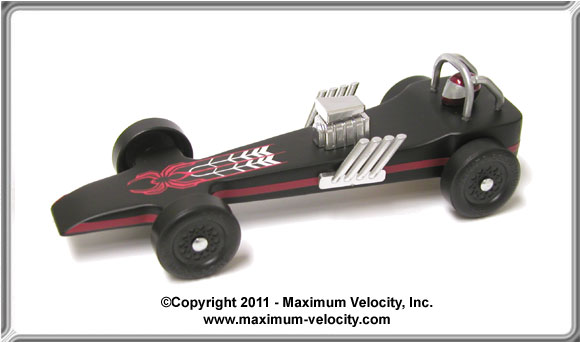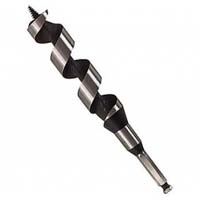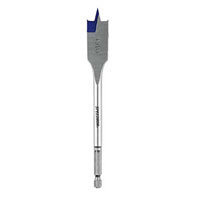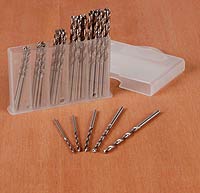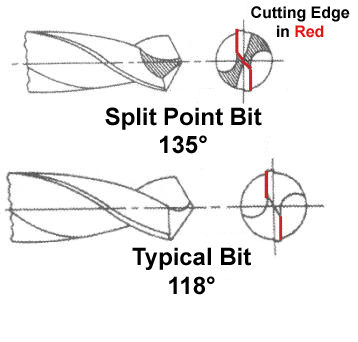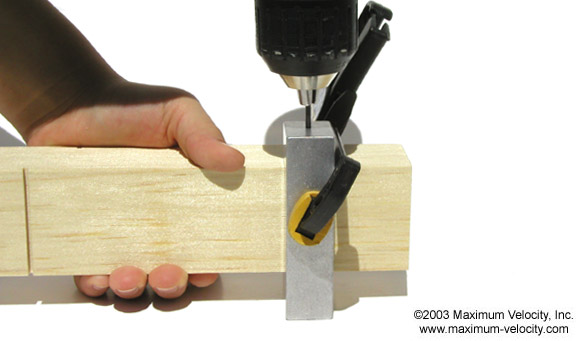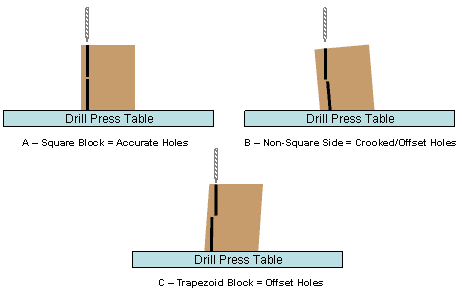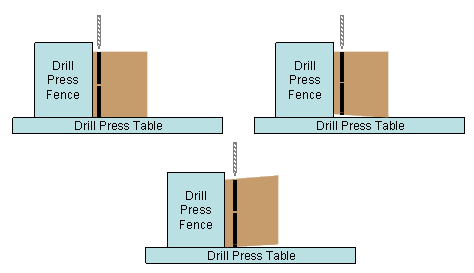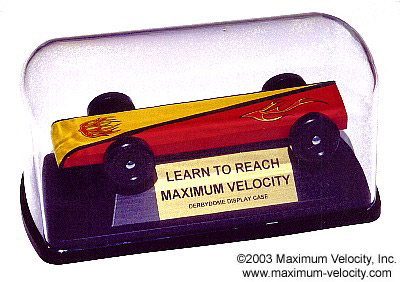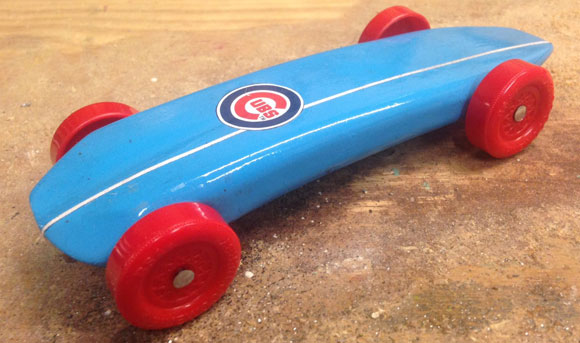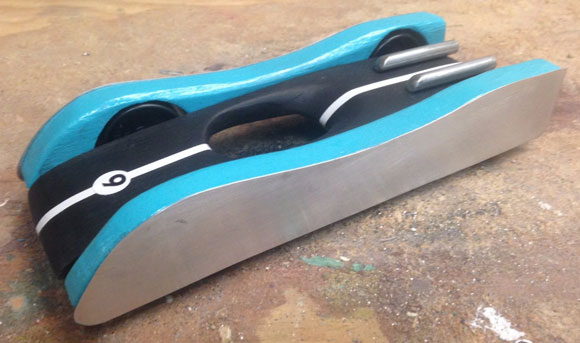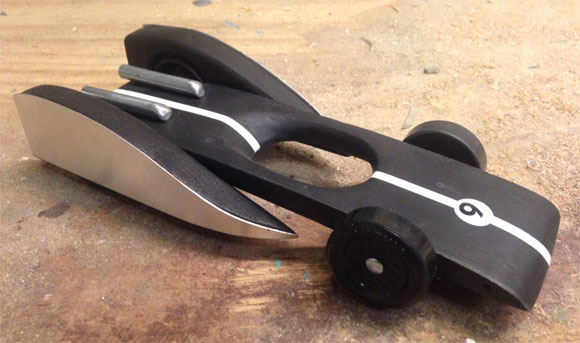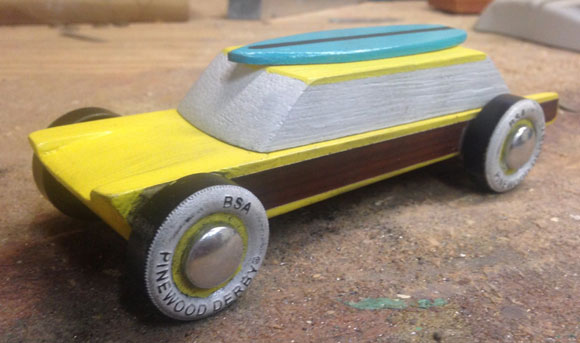– Editor’s Notes
– Feature Article – Drilling – Use your Drill for Maximum Benefit
– Humor
– Product Showcase – DerbyDome – $2.00 Off
– Pinewood Derby Car Showcase
– Pinewood Derby Memory – Priceless!
– Q&A
Editor’s Notes
Three New Products Just In Time For The Racing Season
Maximum Velocity has introduced two new tungsten weights, and a new drill bit to simplify your car building:
Domed Adjustable Tungsten Round (Part 5068) – 
9/32 Inch Tungsten Rod (Part 5067) – Tungsten Rod combines the simplicity of cylindrical weight with the low height benefit of cube weight. These tungsten rods allow thin cars to be built without creating underbody pockets. Each order contains 10 rods totaling 3.5 ounces.
19/64 Inch Brad Point Drill Bit (Part 5004) – The perfect drill bit for the 9/32 Inch Tungsten Rod.
Call for Car Photos
Help, we are virtually out of photos for the pinewood derby car showcase. Please send us a photo of your car along with a description of any special features to:
[email protected]
Please include your full name. If selected, we will include the photo and description in this newsletter.
Photos must be sent by e-mail in JPG format (minimum size of 640×480, maximum size of 1280 x 960). Please shoot photos from the front left of the car, similar to the orientation of this car:
Make sure the photo is not blurry. If your photos are blurry, try holding the camera four or five feet away from the car, and then use the camera’s zoom to fill the frame with the car. Also, use a solid (preferably white) background for the photo.
Send only one photo per car, unless an additional photo is needed to adequately show a feature. Don’t forget to include your name, the name of the car (if it has one), and a brief write up on any design features, inspiration for the design, and how the car performed at the race. Thanks.
MV Basic & Wedge Car Kits

– Quality Block – Unlike the blocks provided by some organizations, our blocks are soft, northwestern pine blocks, cut precisely to 7 inches long, 1-3/4 inches wide, and 1-1/4 inches tall. These dimensions, as well as the axle slots accurately duplicate the dimensions of standard pinewood derby blocks from BSA and PineCar.
– Simple Axle Preparation – Don’t worry about filing off flaws, or losing hub caps. Our Speed Axles have no burrs or crimp marks, and install without hub caps. With or without polishing, they are ready to go. We supply five, so you have a spare.
– Quality Wheels – Forget cheap, out of round wheels. Our MV wheels are top-quality wheels. You will not be disappointed with the quality of these wheels.
So, if your organization does not mandate a particular kit type, consider our MV Basic Car Kits or MV Wedge Car Kits. We also offer bulk packs of MV kits in Pre-cut Shapes.
Inventory Clearance Sale
We are clearing inventory on several items including:
– Tundra and tungsten weights
– Formula One car kits
– Paint Stencils
We don’t have many left, so don’t delay. You can find these items Here.
Can We Help?
If we can help you in any way with your pinewood derby project, or if you have any feedback regarding this newsletter, please Contact Us.
Feature Article
Drilling – Use your Drill for Maximum Benefit
By Randy Davis
Over the years I have learned a lot about drilling into pine blocks, and on several occasions I have shared this information in newsletter articles. This includes drilling accurate axle holes, best drill bit types, etc.(1)
Today’s article is an accumulation of most of my knowledge on drilling as it relates to pinewood derby car building. We will cover the items mentioned above, as well as some drilling techniques. I hope you find the information useful.
Basic Drilling Tips
First, let’s cover some basic tips and techniques that are applicable to any drilling situation, and certainly to any pinewood derby project.
1. Wear eye protection – just one tiny piece of wood thrown into an eye is very painful and oftentimes difficult to remove.
2. Immobilize the wood that is being drilled. With small pieces of wood, such as a pinewood derby body, do not attempt to hold the wood with one hand and drill with the other, as the wood can easily be twisted out of your hand.
3. Drill early, before cutting the wood. It is always easier to drill a rectangular-shaped piece of wood than to drill an irregular shaped piece.
4. Use a medium speed, and start the drill before the bit engages the wood. You can touch the sharp tip of the bit at the drill location and then start the drill, but make sure the cutting edge of the bit is not contacting the wood when the drill is started. Otherwise the wood can be torqued, or the drill can be twisted out of your hand.
5. When drilling deep holes, drill part of the hole, then, with the drill still running, pull the bit out of the wood to clear the chips from the hole. Then drill the rest of the hole.
6. When drilling completely through a piece of wood, place a scrap piece of wood tightly against the exit point of the hole to be drilled. Then drill through the wood and into the scrap piece. This will minimize chipping at the exit point.
Drill Bits for Weight Holes
When the phrase “drill bit” is used, the image that comes to the mind of most people is a standard high-speed steel (HSS) drill bit that is part of the drill bit set in most people’s toolbox. This type of drill bit is certainly the most popular, but it is not the best drill bit choice for many woodworking tasks, including drilling axle holes.
Regardless of the drill bit type, make sure to know the chuck size of your drill. The chuck size determines the maximum shaft diameter of the drill bit that can be used. Most drills today have either a 3/8 or 1/2 inch chuck. If your chuck is 3/8 inch, make sure to purchase bits with a shaft no larger than 3/8 inch.
There are many different types of drill bits available at your local hardware store including Forstner, Brad Point, Auger, Spade (or Paddle), HSS, Carbide, and Cobalt.(2) Let’s look at each one.
Forstner – Produces a flat-bottomed, clean edged hole with no chipping. The center point ensures that the hole is drilled where desired. For drilling holes over 7/16 inch, Forstner Bits are generally a better value than Brad Point bits. Some Forstner bits have a saw tooth edge (as seen in the photo) while others do not. Either type works well for pinewood derby use.
Forstner bits are commonly used for creating wheel wells for attaching to the side of a pinewood derby block. They are also used for creating holes for tungsten rounds.
Figure 1 – Forstner Drill Bit
Brad Point – Produces a clean edged hole with no chipping. The center point ensures that the drill bit doesn’t wander. For drilling holes between 1/8 and 7/16 inch, Brad Point bits are usually a better value than Forstner bits and do a better job than HSS bits.
Brad Point bits are commonly used for drilling weight holes in pinewood derby blocks.
Figure 2 – Brad Point Drill Bit
Auger – Produces a clean, accurate hole. The screw tip causes the bit to “power feed”, and the auger shape helps in chip removal, so this type of bit is beneficial for drilling very deep holes.
Although Auger bits can be used for pinewood derby cars, Brad Point or Forstner bits are usually a better choice. The screw tip on the Auger bit is not desirable for pinewood derby cars as it makes the hole too deep, and the power feed action can be unwieldy for novice woodworkers.
Figure 3 – Auger Drill Bit
Photo Source: www.toolbarn.com
Spade – Also known as a “Paddle Bit” this type of inexpensive bit is used for rough boring. Typically, they are used in carpentry where a clean hole is not necessary. I strongly recommend avoiding Spade Bits for pinewood derby use as they create a rough hole.
Figure 4 – Spade Bit
Photo Source: www.drillspot.com
Drill Bits for Axle Holes
If your pinewood derby race rules allow axle holes, then you have likely drilled the holes using a drill press, or a Pro-Body Tool or Pro-Axle Jig.(3) For Cub Scout axles, a #44 bit is recommended, while a 3/32 inch bit is typically used for Awana axles. For a few other kits, a #43 bit works well. But regardless of the bit size, there is a difference in the type of bit used. These include HSS, Carbide, and Cobalt.
HSS – A general purpose drill bit for use in wood, metal, plastic, etc. Especially in larger sizes, HSS bits often chip the edge of the hole, and can “wander” (i.e., not entering the wood at the location you want).
HSS drill bits are flexible and strong. They are inexpensive and used where long-term durability of the cutting edge is not important. The flexibility of the HSS bit is helpful in minimizing broken bits, but the flexibility is a hindrance where accuracy is concerned.
For drilling axle holes with a Pro-Body Tool/Jig, a HSS bit is fine, as the tool minimizes the flexing and wandering of the bit; but when drilling holes with a drill press the flexibility really hinders accuracy.
Figure 5 – HSS Drill Bit
Photo Source: www.rockler.com
Carbide – An extremely hard bit with a durable cutting edge. Due to the rigidity flexing is virtually eliminated. However, because they do not flex, they are prone to breakage if careful technique is not applied. Carbide bits often come with a shank larger than the bit. So, if you purchase one, make sure to get one that is long enough to drill axle holes – many Carbide bits are too short for drilling axle holes.
Figure 6: Typical Carbide Bit
(Source: www.carbidespecialties.com)
Cobalt – An extremely hard bit with a with a durable cutting edge. Due to the rigidity, flexing is virtually non-existent. But Cobalt bits have a big advantage over HSS and Carbide bits – Cobalt bits have a “split point” tip that is specifically designed to keep the bit from
“wandering”.
Wood is a relatively soft medium, but it is not consistent in density. Depending on the grain, wood will change from a hard to soft density over a small fraction of an inch. This change in density affects the way the drill bit goes into the wood. The drill bit will seek to go into the softer part of the wood. With a HSS bit, the bit may wander seeking a soft spot, and then when it has entered the wood it will tend to flex away from the hard grain. This results in inaccurate holes. Carbide bits also wander, and if they wander when in a drill press, due to the rigidity of the bit either the wood will move, or the bit will break. It seems odd, but I have broken more carbide bits when drilling into wood than any other type of bit.
Cobalt bits, with their split point, are virtually wander-free. Like other bits, once the bit enters the wood it will want to follow the softer grain, but this can be compensated for with proper drilling technique.
Figure 7: Cobalt Split Point vs. Typical Bit
Drilling Techniques for Axle Holes
Excellent wheel alignment is a key factor in creating a competitive pinewood derby car, and using drilled axle holes (instead of slots) is a key way to improve wheel alignment. Of course, this assumes that the axle holes are drilled accurately.
The information below will address how to drill accurate axle holes (and some inferior techniques that you want to avoid) with either a hand drill/Pin Vise or a drill press. But before drilling axle holes make sure to check your local rules to make sure they are acceptable for your race.
Hand Drill/Pin Vise
To accurately drill axle holes with a hand drill or a Pin Vise you must use a drilling guide: either a Pro-Body Tool or Pro-Body Jig. Do not attempt to freehand-drill axle holes – the results will likely be much worse than using the axle slots.
The Pro-Body Tool is a drilling guide designed specifically for drilling axle holes in pinewood derby blocks.
Figure 8 – Pro-Body Tool
It is placed over the bottom of the block, and then clamped into place. The drill bit is then run through the holes in the Pro-Body Tool. The metal of the tool ensures that the drill bit goes straight into the wood. Full instructions for using the Pro-Body Tool are located Here. However, here are a few additional tips.
1. Keep the drill bit aligned with the hole in the tool. Don’t flex the drill bit – it can break.
2. Make sure the Pro-Body Tool fits snugly on the wood. If it is loose, use paper to shim it; if it is too tight sand the sides of the wood block.
3. The Pro-Body Tool is equipped with a separate guide hole for drilling a raised hole for one of the front axles.
Drill Press
The Pro-Body Tool is highly accurate, and in some ways preferable to a drill press. But for more flexibility in hole placement, and for drilling larger quantities of blocks the drill press is a good option.
The principle employed by the Pro-Body Tool is that all holes are referenced to the bottom of the block. Thus, an out of square block will not affect the accuracy of the axle holes.
This same principal must be employed when using a drill press. Thus, when using a drill press, an accurate, vertical fence must be present.(4) By pressing the bottom of the block to the vertical fence the holes will be referenced to the bottom of the block, eliminating any issues due to an out of square block. The fence will also ensure that each hole is drilled at exactly the same height off the bottom of the block.
However, most people with a drill press do not use a vertical fence. Instead, they place the left side of the block on the drill press table and drill the right-side holes. Then they flip the block over, and drill the left side holes. This will result in holes that are not exactly the same height off the bottom of the block, and, if the block is not perfectly square, the resulting holes will not be parallel to each other, leading to poor alignment. This is shown – in an exaggerated fashion – in Figure 9.
Figure 9 – Inaccurate Holes Due to Out of Square Blocks
Some people attempt to resolve this issue by using a long drill bit to completely drill through the block. However, since the drill bit is narrow and long, it will flex, leading to inaccurate holes. This is especially true in pine, as the wood tends to have hard and soft layers which causes the drill bit to flex.
Instead, it is best to use a short bit, and drill half way through the block. As mentioned earlier, issues due to non-square blocks can be resolved by using an accurate vertical fence. The key is to make sure the block is clamped firmly to the fence, even if the side of the block is not flush against the drill press table (see Figure 10).
Figure 10 – Vertical Fence Creates Accurate Holes Regardless of Block
Shape
To minimize the effect of soft and hard grain on the drill bit path, squeeze (or clamp) the block to the fence, then enter the wood slowly. After drilling half of the hole, pull the bit out to clear the wood chips, then complete the hole. Drilling slowly will minimize the affect of the hard portion of the wood grain on the drill bit path.
Conclusion
Inaccurate drilling can lead to slower performance and lots of patching. But with the proper drill bits, equipment, and technique, accurate drilling is achievable by anyone.
(1) Additional information can be found in the following articles:
Drilling with Accuracy
Drilling Small Holes
Drilling Axle Holes with Precision
(2) Specific drill bits for pinewood derby use can be found Here.
(3) The Pro-Body Tool and Pro-Body Jig can be found Here.
(4) Meaning that the side of the fence is perfectly parallel with the drill bit.
Humor
Tricky Questions II
[answers are below]
1. The maker doesn’t want it; the buyer doesn’t use it; and the user doesn’t see it. What is it?
2. A child is born in Boston, Massachusetts to parents who were both born in Boston, Massachusetts. The child is not a United States citizen. How is this possible?
3. Before Mount Everest was discovered, what was the highest mountain on Earth?
4. Clara Clatter was born on December 27th, yet her birthday is always in the summer. How is this possible?
5. Captain Frank and some of the boys were exchanging old war stories. Art Bragg offered one about how his grandfather led a battalion against a German division during World War I. Through brilliant maneuvers he defeated them and captured valuable territory. After the battle he was presented with a sword bearing the inscription “To Captain Bragg for Bravery, Daring and Leadership. World War I. From the Men of Battalion 8.” Captain Frank looked at Art and said, “You really don’t expect anyone to believe that yarn, do you?” What’s wrong with the story?
6. What is one thing that all wise men, regardless of their religion or politics, agree is between heaven and earth?
7. In what year did Christmas and New Year’s fall in the same year?
8. A woman from New York married ten different men from that city, yet she did not break any laws. None of these men died and she never divorced. How was this possible?
9. Why are 1990 American dollar bills worth more than 1989 American dollar bills?
Answers
1. A coffin
2. The child was born before 1776
3. Mount Everest, it just hadn’t been discovered!
4. Clara lives in the southern hemisphere.
5. World War I wasn’t called “World War I” until World War II.
6. The word “and”.
7. They fall in the same year every year, New Year’s Day just arrives very early in the year and Christmas arrives very late in the same year.
8. The lady was a Justice of the Peace.
9. One thousand nine hundred and ninety dollar bills are worth one dollar more than one thousand nine hundred and eighty-nine dollar bills
Product Showcase
DerbyDome – $2.00 Off
A Great Christmas Present
The DerbyDome is a high-quality case for safely displaying pinewood derby cars. The DerbyDome has the following features:
– Heavy duty, clear dome fits snuggly with the black pedestal to keep cars dust free while providing a complete view of the car.
– No-tools-required fastening system keeps the car in place – fits BSA, Awana, and other wheels.
– Car may be mounted horizontally or tilted to either side.
– Product includes: dome, pedestal, 2 mounting brackets, blank paper identification labels, and assembly instructions.
– Custom nameplate can be ordered through the manufacturer (order form included).
Through December 26, 2017, you can get a DerbyDome for $2.00 off. To take advantage of this limited time offer, add part 5210 to your shopping cart and use coupon code DEC13NL during checkout.
Pinewood Derby Car Showcase
Today’s cars are from Dan Schuster
Chicago Cubs
My son and new Scout, Ollie, wanted a Chicago Cubs car. This was our best one and it was extremely fast on the flats. We based its design on a teardrop shape, making the body as thin as possible while still keeping it shapely. We opted to reverse the shape by designing it with a short nose and long tail. We’d like to place the success we had on the Cubs sticker.
Salt Flat Racer – Original and Version 2
My other son, Henry wanted his car to look differently than the others, so we made a black salt-flat racer complete with balsa and aluminum wheel fairings. The original had a full fairing covering all four wheels. In the end it proved to have the weight spread out along the entire body, hence, the updated 2 wheel fairing. All the weight as centered around the rear axle. It too did very well, but we were shooting for looks on this one.
Family Truckster
The yellow family truckster was loosely based on a car we saw online but we put our own spin on it. Oddly enough, it was unexpectedly quick considering the higher, less sleek profile. The entire body was hollowed out as the top portion was paper-thin balsa wood with a coating of wood glue for strength. This one was the family build.
Share Your Car With Our Readers
Do you have a car you would like to “show off” to our readers? If so, send us a photo of your car along with a description of any special features to:
[email protected]
Please include your full name. If selected, we will include the photo and description in this newsletter.
Photos must be sent by e-mail in JPG format (minimum size of 640×480, maximum size of 1280 x 960). Please shoot photos from the front left of the car, similar to the orientation of this car:
For better focus, keep the camera four or five feet away from the car, and then use the camera’s zoom to fill the frame with the car. Also, use a solid (preferably white) background for the photo.
Send only one photo per car, unless an additional photo is needed to adequately show a feature. Also, only one car per subscriber per year please. Thanks.
Pinewood Derby Memory
Priceless!
Yesterday our troop ran a derby for a pack at a church. I was score keeping and the scouts were handling the registration, starting gate and finish line. During one heat the scout on the gate let the handle slip out of his hand and the rebounding pins launched two cars off the track to the floor. One car, a wedge, hit nose first and broke the right front quarter back to the axle completely off the car.
I called an official time out and asked the scout if he wanted to repair his car. He indicated he would like to, but he needed help. Well, I took him to the pits repaired the car with epoxy, did a quick alignment with one wheel raised, lubed, and glued the axles down. We allowed him two practice runs and continued the race.
He had been in the losers bracket with one loss at the time of the accident. He went on to take 2nd Place in the pack. Glue? – about five cents. Lube? – maybe a penny. My time? – nothin’. The expression on his face? – priceless!
Jamie
Do you Remember?
If you have a pinewood derby story that is funny, unusual, sad, heart-warming, etc., please send it to me in an e-mail. Don’t worry about literary polish. We will edit as needed before publishing. If your story is used, you will receive a $10 coupon in May of 2017.
Q&A
Q: My daughter and I made two cars this past spring. She took first place in the standard division and in the outlaw races. But for the outlaw race next year, we want to use the full weight allowed. She won using a 5 ounce car this past year, but they allow for a 1 pound maximum. We used the 4060 Pro Ultralite BSA wheels for the 5 ounce cars, but I don’t think those wheels would hold up well on a 1 pound car. Which wheels would you recommend for a car that heavy? We want to use BSA wheels so people won’t complain that we did not use the parts from the kit. Should we make the car lighter?
A: Congratulations on the victory last year.
I did some testing on maximum weight for performance – you can find it Here. With graphite lube, I would not go over 9 ounces. With Krytox 100 lube, you could go up to 14.5 ounces.
I would go with a sturdier wheel – probably the 4090 Speed Wheels.
But if you won by a decent margin last year, you might stick with a lighter weight car and lighter wheels. The effect of 1g wheels is likely about 0.04 seconds advantage.
On a 9 ounce car with graphite, the benefit was only .03 seconds, so this could be a step down. With Krytox 100, you may get enough advantage to overcome the advantage of lighter wheels.
Q: When we paint our cars, we use automotive paint from AutoZone. We put on a nice coat of primer, sand it with high grit sandpaper, and repeat until perfectly smooth. Then we apply the color coat. I have never known what I should do about the area where the hub of the wheel could potentially rub on the body of the car. I have heard that it should not be painted and instead use a No. 2 pencil to rub lead into the bare wood. What do you recommend?
A: I prefer to paint the area the same as the rest of the car. Assuming you use a clear coat, you will have a very slick surface. With a high-quality graphite on the inner hub, it will work fine. In my opinion, this is better than bare wood with graphite. But if you go with bare wood, rub high-quality graphite into the surface. Don’t use a pencil, as pencil lead is low-grade graphite mixed with clay.
Want Answers?
Do you have a pinewood derby-related question? If so, e-mail us your question.We answer all questions by e-mail, but not every question will appear in the Q&A section of the newsletter.
Back Issues
Are you a new subscriber, or have you missed some of the previous newsletters? Don’t miss out; all of the issues for Volume 5 through Volume 17 are posted on our web sit.
Newsletter Contributions
We welcome your contributions. If you would like to contribute an article, a web site review, a speed tip, or a pinewood derby memory, please e-mail us.
Subscription Information
The Pinewood Derby Times is a free e-newsletter focused on pinewood derby racing. It is published biweekly from October through March.
If you haven’t already done so, please forward this issue to your pinewood derby friends. But please don’t subscribe your friends. Let them decide for themselves. Thanks.
If this newsletter was forwarded to you, why not subscribe to receive this newsletter. There is no cost, and your e-mail address is safe, as we never sell or share our distribution list.
To subscribe, send a blank e-mail to
[email protected]
You will receive a confirmation e-mail. Reply to the confirmation e-mail and you will start receiving the Pinewood Derby Times with the next issue.
Randy Davis, Editor, Pinewood Derby Times
E-Mail: [email protected]
(C)2017, Maximum Velocity, Inc. All rights reserved. Please do not reprint or place this newsletter on your web site without explicit permission. However, if you like this newsletter we grant permission, and encourage you to e-mail it to a friend.
Maximum Velocity disclaims any personal loss or liability caused by utilization of any information presented in this newsletter.
The Pinewood Derby Times is not specific to, and is not affiliated with the Boy Scouts of America, YMCA, Awana, or any other organization.
(R)Maximum Velocity is a registered trademark of Maximum Velocity, Inc.
(R)Pinewood Derby is a registered trademarks of the Boys Scouts of America.
(R)Awana is a registered trademark of Awana Clubs International.
All other names are trademarks of their respective owners.


